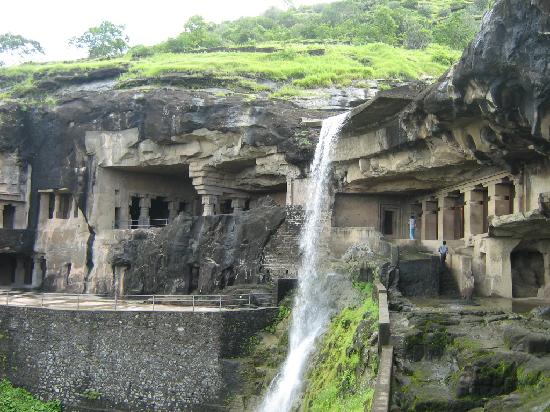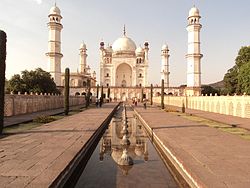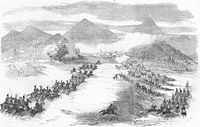Visit to Aurangabad

Aurangabad was founded in 1610 A.D.[citation needed] by Malik Ambar, the Prime Minister of Murtaza Nizam Shah of Ahmadnagar, on the site of a village called Khadki. He made it his capital and the men of his army raised their dwellings around it. Within a decade, Khadki grew into a populous and imposing city. Malik Ambar cherished strong love and ability for architecture. Aurangabad was Ambar's architectural achievement and creation. Malik Ambar died in 1626.[3] He was succeeded by his son Fateh Khan, who changed the name of Khadki to Fatehnagar. With the capture of Daulatabad previously known as Devagiri by the imperial troops in 1633, the Nizam Shahi dominions, including Fatehnagar, came under the possession of the Moghals.
In 1653 when Prince Aurangzeb was appointed the viceroy of the Deccan for the second time, he made Fatehnagar his capital and renamed it Aurangabad. Aurangabad is sometimes referred to as Khujista Bunyad by the Chroniclers of Aurangzeb's reign.
Bibi Ka Maqbara 1880s

Bibi Ka Maqbara was built in 1660 by Aurangzeb's son, Azam Shah, as a loving tribute to his mother, Dilras Bano Begam. In 1720, Nizam-ul-Mulk Asif Jah, a distinguished General of Aurangzeb with the intention of founding his own dynasty in the Deccan, arrived at Aurangabad and made it his capital. He paid a visit to Delhi in 1723, but returned in 1724, Nizam Ali Khan Asaf Jah II transferred his capital from Aurangabad to Hyderabad in 1763.[4]
Aurangabad was a part of Nizam's princely Hyderabad State until its annexation into Indian Union and thereafter a part of Hyderabad state of India until 1956. In 1956 it became a part of newly formed bilingual Bombay state and in 1960 it became a part of Maharashtra state.
[edit] 1857 War of Independence
1857 War of Independence

The year 1857 was eventful in the history of Aurangabad with the rest of the country. The British moved the first cavalry from Mominabad (Ambejogai) to Aurangabad to relieve 3rd cavalry which had marched to Malegaon, and was the first regiment to show signs of disaffection. The 2nd Infantry also came under suspicion. The authorities at Hyderabad were kept informed of the course of events by express. Upon this, a column of troops was ordered to march from Pune to Aurangabad. In the meanwhile, the artillery was also showing signs of rebellion, but the rumour of Bombay troops marching towards Aurangabad had a quieting effect. The men of the cavalry also returned to their posts

Aurangabad was founded in 1610 A.D.[citation needed] by Malik Ambar, the Prime Minister of Murtaza Nizam Shah of Ahmadnagar, on the site of a village called Khadki. He made it his capital and the men of his army raised their dwellings around it. Within a decade, Khadki grew into a populous and imposing city. Malik Ambar cherished strong love and ability for architecture. Aurangabad was Ambar's architectural achievement and creation. Malik Ambar died in 1626.[3] He was succeeded by his son Fateh Khan, who changed the name of Khadki to Fatehnagar. With the capture of Daulatabad previously known as Devagiri by the imperial troops in 1633, the Nizam Shahi dominions, including Fatehnagar, came under the possession of the Moghals.
In 1653 when Prince Aurangzeb was appointed the viceroy of the Deccan for the second time, he made Fatehnagar his capital and renamed it Aurangabad. Aurangabad is sometimes referred to as Khujista Bunyad by the Chroniclers of Aurangzeb's reign.
Bibi Ka Maqbara 1880s

Bibi Ka Maqbara was built in 1660 by Aurangzeb's son, Azam Shah, as a loving tribute to his mother, Dilras Bano Begam. In 1720, Nizam-ul-Mulk Asif Jah, a distinguished General of Aurangzeb with the intention of founding his own dynasty in the Deccan, arrived at Aurangabad and made it his capital. He paid a visit to Delhi in 1723, but returned in 1724, Nizam Ali Khan Asaf Jah II transferred his capital from Aurangabad to Hyderabad in 1763.[4]
Aurangabad was a part of Nizam's princely Hyderabad State until its annexation into Indian Union and thereafter a part of Hyderabad state of India until 1956. In 1956 it became a part of newly formed bilingual Bombay state and in 1960 it became a part of Maharashtra state.
[edit] 1857 War of Independence
1857 War of Independence

The year 1857 was eventful in the history of Aurangabad with the rest of the country. The British moved the first cavalry from Mominabad (Ambejogai) to Aurangabad to relieve 3rd cavalry which had marched to Malegaon, and was the first regiment to show signs of disaffection. The 2nd Infantry also came under suspicion. The authorities at Hyderabad were kept informed of the course of events by express. Upon this, a column of troops was ordered to march from Pune to Aurangabad. In the meanwhile, the artillery was also showing signs of rebellion, but the rumour of Bombay troops marching towards Aurangabad had a quieting effect. The men of the cavalry also returned to their posts
No comments:
Post a Comment